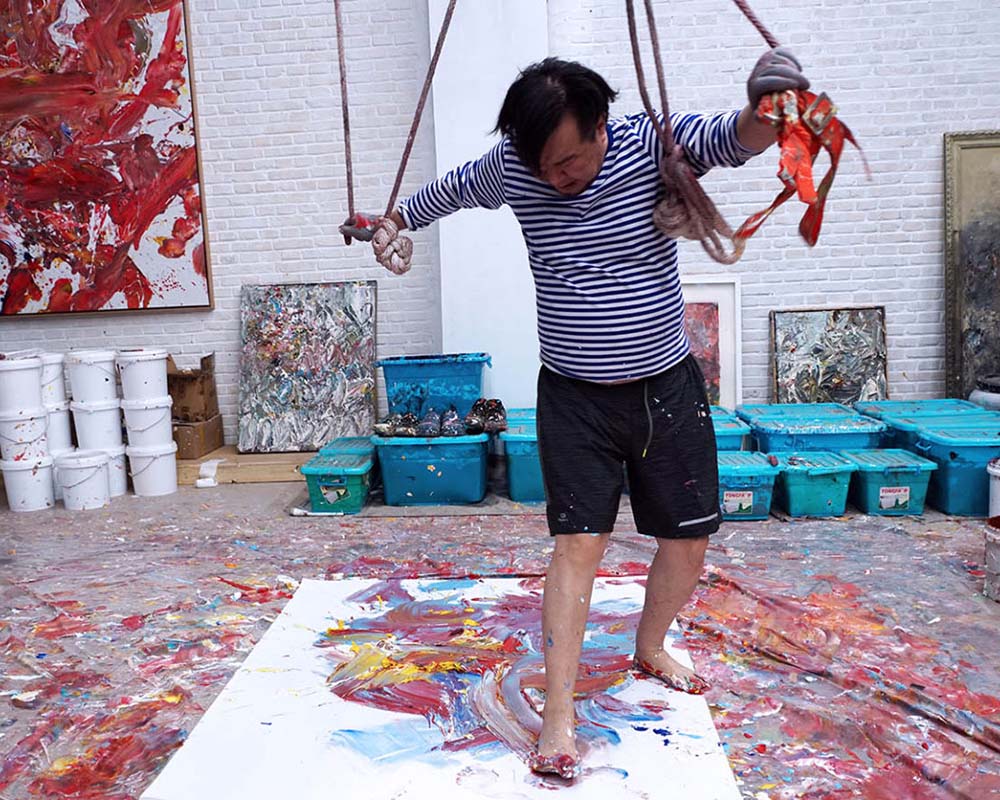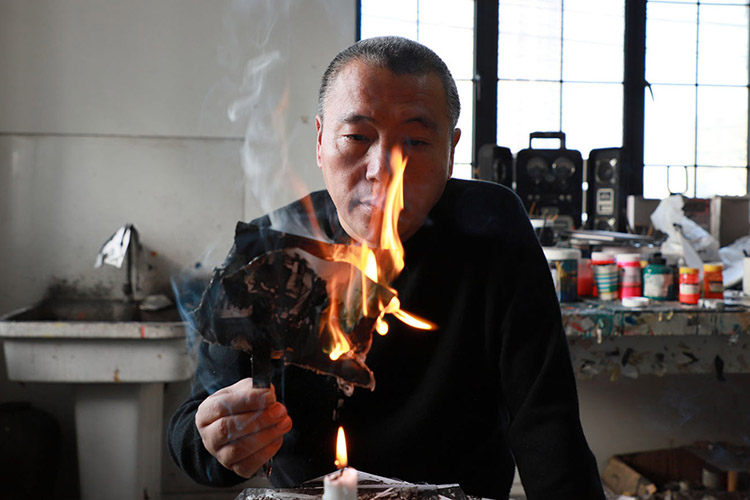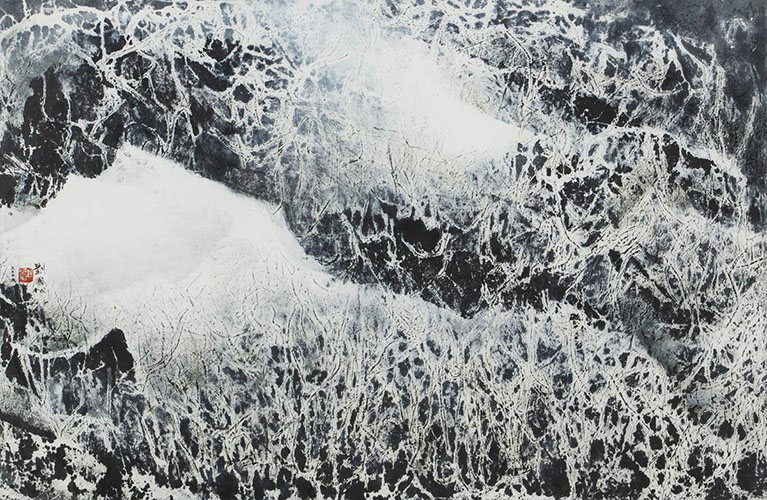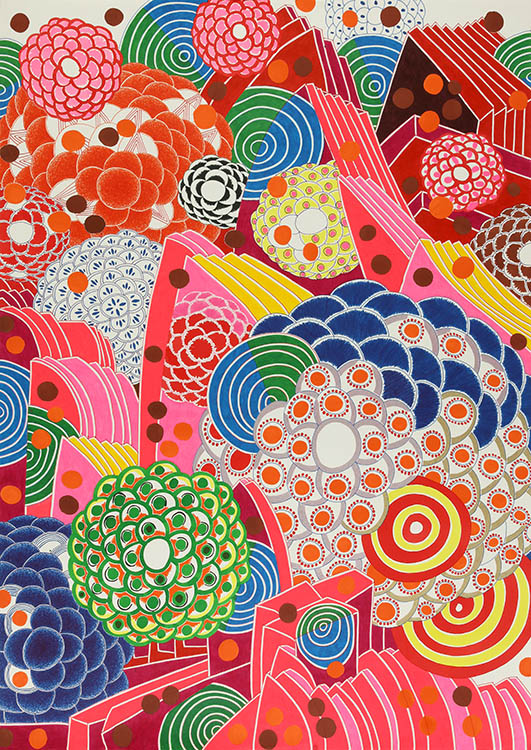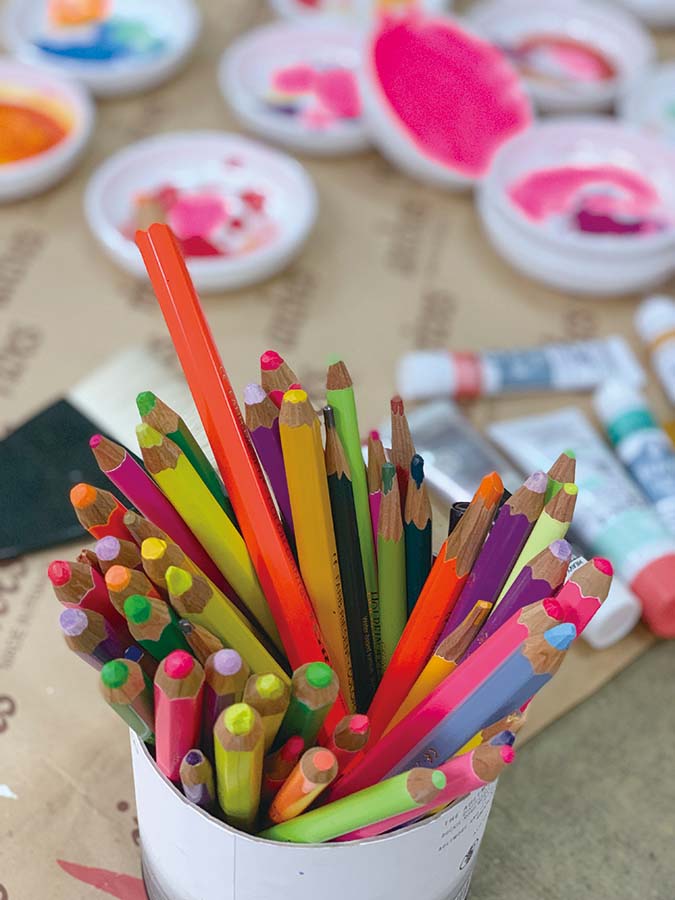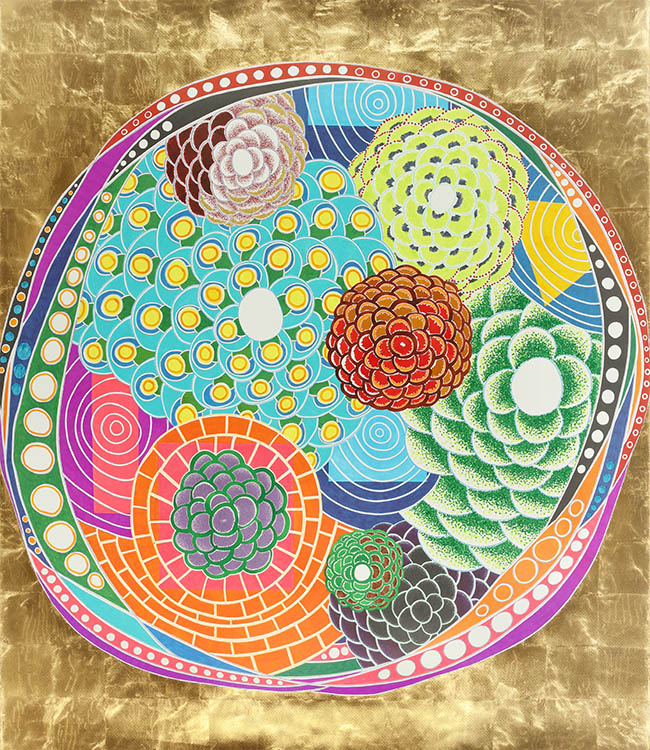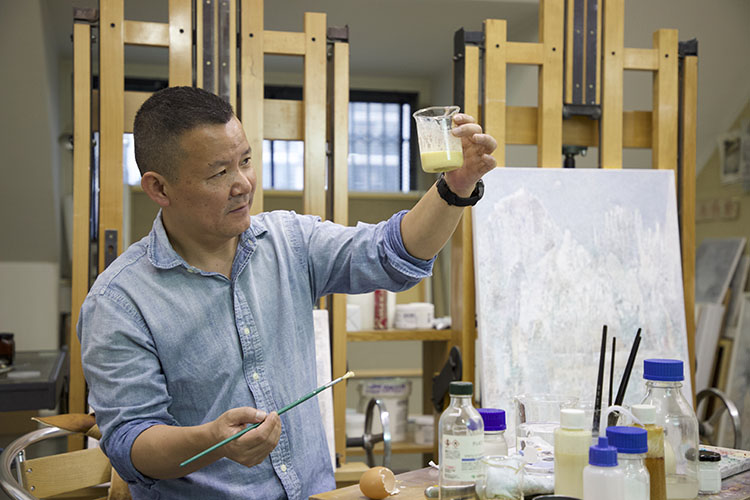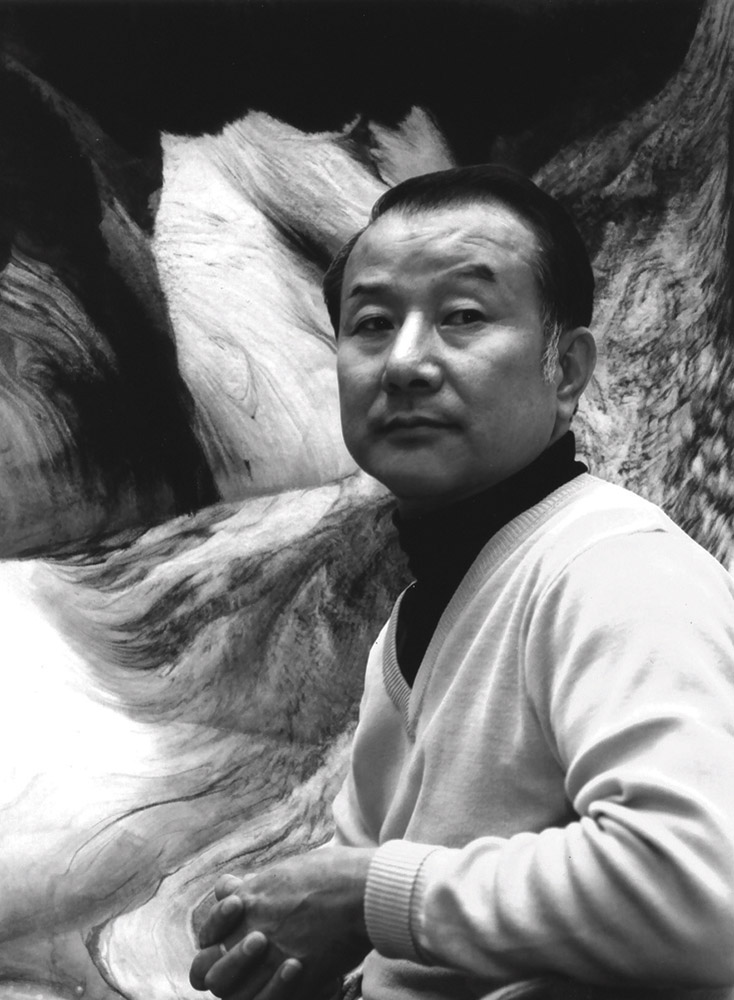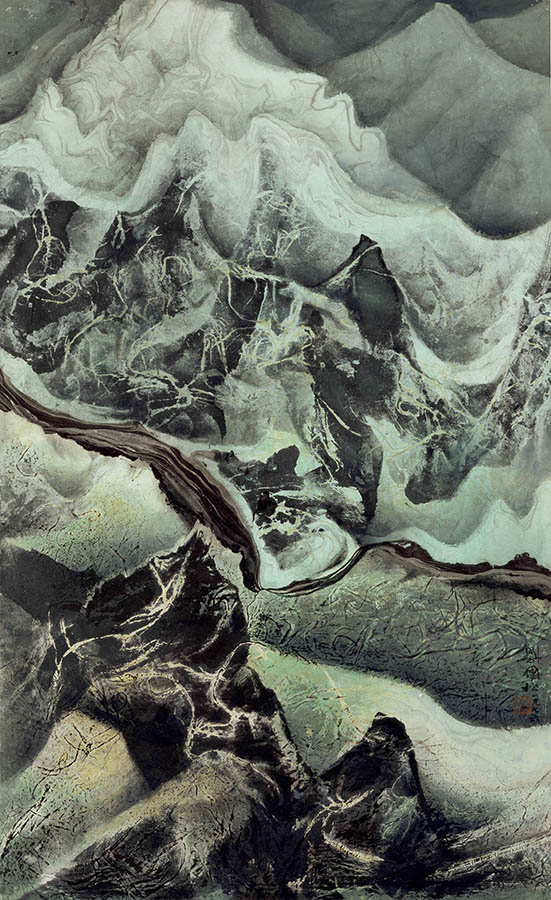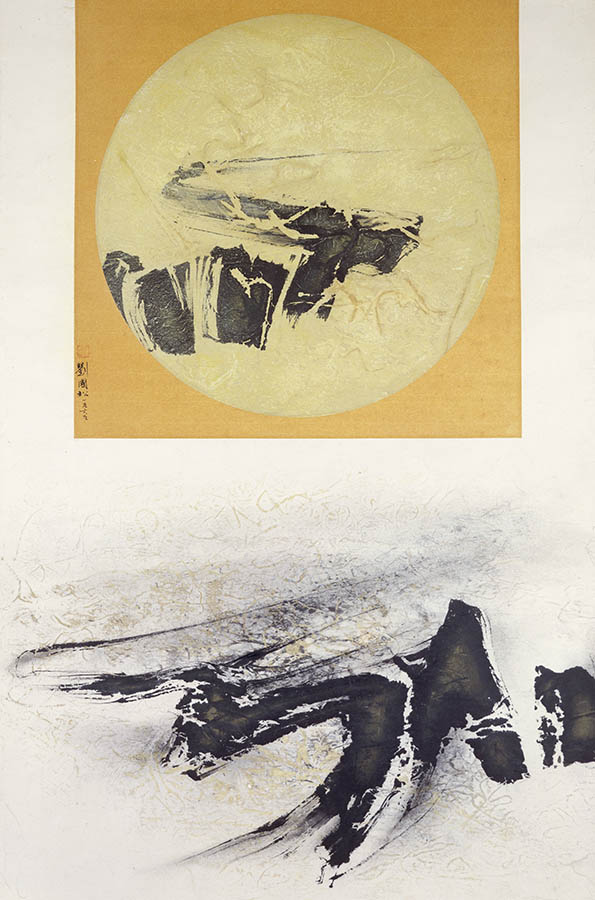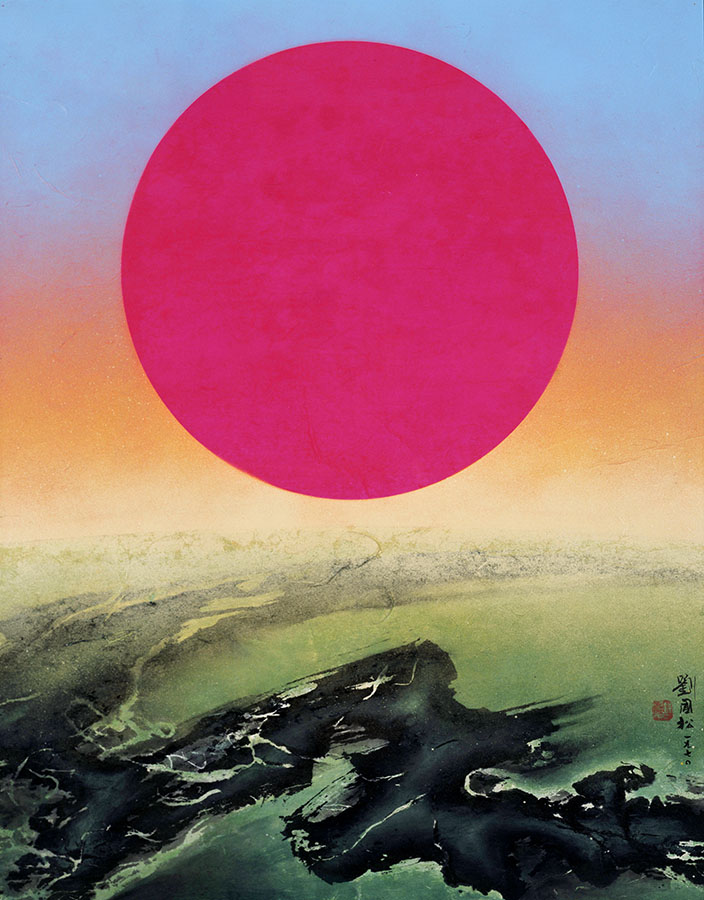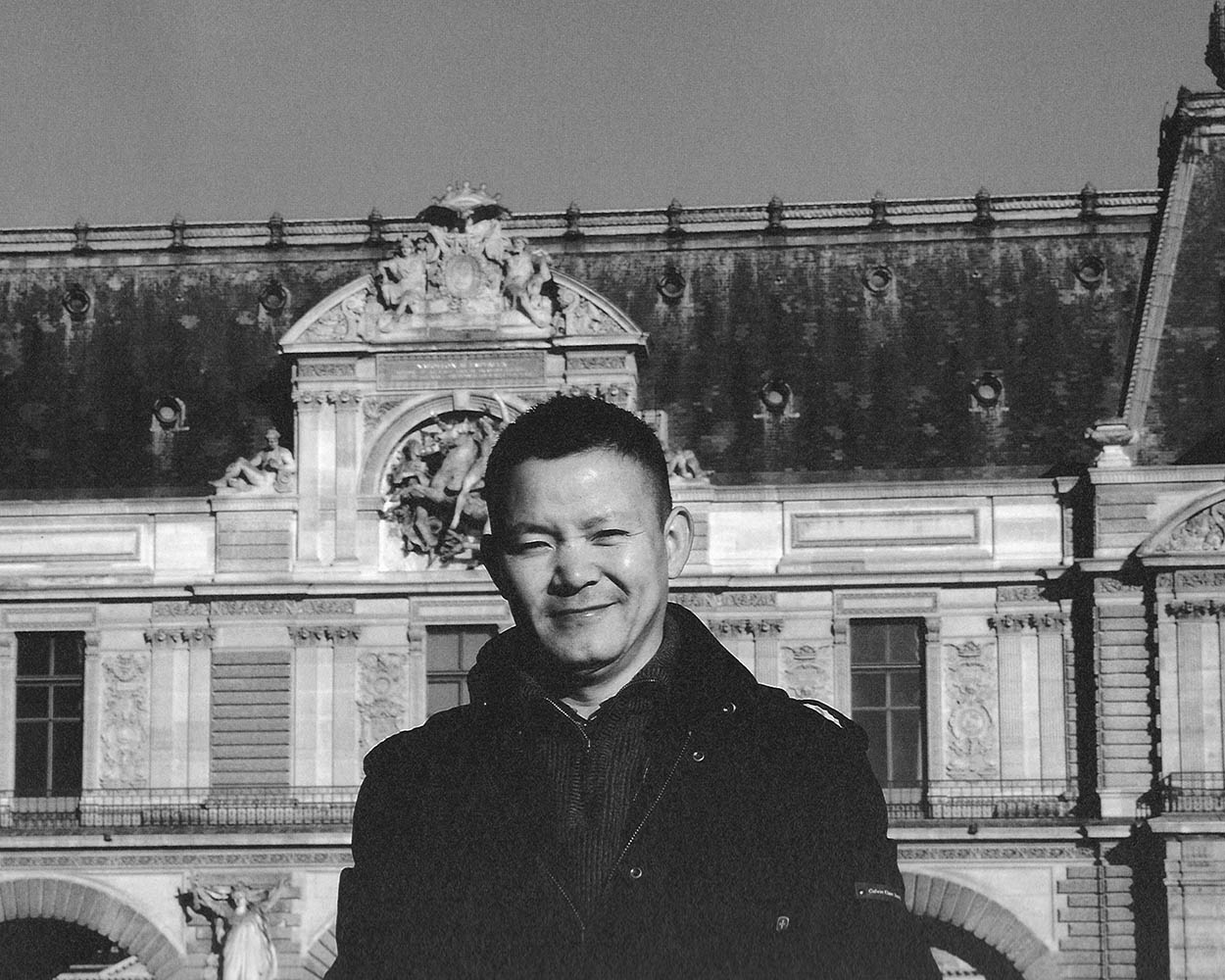NEW Essays
Essay
Su Chung-ming’s landscapes leap off the paper and call to the mountains outside
Seemingly speaking a thousand words, but spoken in solemn silence
The worries of the world are lost beyond the sky
Aesthetic theorist Zong Baihua (1897–1986) introduced in An Aesthetics Anthology that the most profound sentiment in Chinese painting is “to silently be molded by and thus become one with the infinite reality of nature and space.”
Su Chung-ming, Misty Valley (detail), 2021 © Su Chung-ming
Essay
Nihonga in Taiwan
The term Nihonga was coined in Meiji Japan (1868 – 1912), during a time of growing nationalist sentiments brought on by the many challenges of Westernization. The genre came to represent a style of modern Japanese painting, as a response to the rise of Western art, which some nationalists saw as a threatening byproduct of Western imperialism.
Chen Pei-yi, Offering of Carp (detail), 2024 © Chen Pei-yi
Essay
A common theme in Lyse Lemieux’s latest works is the presence of strange figures that bare loose resemblance to human beings. In both Hiatus and Tree Figures, the figures stand upright and appear to have bipedal appendages capable of walking. In Sans Titre (Jambes), although the number of appendages grows disproportionately high, the figure nonetheless bares human-like facial features, depicted clearly in profile view. Yet, in all three paintings, the figures are fundamentally non-human. Instead, they appear as fantastical beings akin to mythological creatures.
Lyse Lemieux, Hiatus, 2022 © Lyse Lemieux. Photo: Rachel Topham
New Catalog Entries
Catalog Entry
Taiwanese artist Lin Li-li’s mineral pigment on silk paintings artworks have a misty and nostalgic atmosphere. When facing her works, the viewer’s impressions and thoughts are frozen deep in memory. Her use of colour is simple and elegant, with brushstrokes that gradually blur. Her compositions convey a sense of time, transporting the scenery into the past. Although not too distant, these memories are already fading.
Lin Li-li, BOLERO, 2024 © Lin Li-li
Catalog Entry
Lyse Lemieux’s recent series Untitled Dress in 2 Parts showcases strong visual style and explore the relationship between clothing and the wearer, and between object and subject. Notably, each work is divided into two parts, aptly named in 2 Parts, which invites curiosity. Lemieux’s work often contains thought-provoking concepts that extend beyond mere visual changes and playfulness.
Lyse Lemieux, Untitled Dress in 2 Parts, 2021 © Lyse Lemieux. Photo: Courtesy of the Artist
Catalog Entry
Lin Li-li’s mineral pigment (Nihonga) on silk paintings posses a faint nostalgic atmosphere. They appear as impressions or thoughts frozen deep in one’s memory. While holding both a Bachelor and Master of Fine Art from Tunghai University, the centre of mineral pigment painting in Taiwan, her works differ greatly from the conventional grand and elaborate style traditionally associated with the genre.
Lin Li-li, Bathhouse with View of Mount Fuji, 2023 © Lin Li-li
archive
Catalog Entry
Taiwanese artist Lin Li-li’s mineral pigment on silk paintings artworks have a misty and nostalgic atmosphere. When facing her works, the viewer’s impressions and thoughts are frozen deep in memory. Her use of colour is simple and elegant, with brushstrokes that gradually blur. Her compositions convey a sense of time, transporting the scenery into the past. Although not too distant, these memories are already fading.
Lin Li-li, BOLERO, 2024 © Lin Li-li
Catalog Entry
Lyse Lemieux’s recent series Untitled Dress in 2 Parts showcases strong visual style and explore the relationship between clothing and the wearer, and between object and subject. Notably, each work is divided into two parts, aptly named in 2 Parts, which invites curiosity. Lemieux’s work often contains thought-provoking concepts that extend beyond mere visual changes and playfulness.
Lyse Lemieux, Untitled Dress in 2 Parts, 2021 © Lyse Lemieux. Photo: Courtesy of the Artist
Catalog Entry
Lin Li-li’s mineral pigment (Nihonga) on silk paintings posses a faint nostalgic atmosphere. They appear as impressions or thoughts frozen deep in one’s memory. While holding both a Bachelor and Master of Fine Art from Tunghai University, the centre of mineral pigment painting in Taiwan, her works differ greatly from the conventional grand and elaborate style traditionally associated with the genre.
Lin Li-li, Bathhouse with View of Mount Fuji, 2023 © Lin Li-li
Catalog Entry
Su Chung-ming’s landscapes give the viewer a sense of freshness, and the same is true of Four Views of a Landscape – Summer. The circular album leaf format sets the scale of the composition. The painting captures the fine details of a mountain, focusing in on a steep cliffside. The brushwork is non-traditional and is comprised of a network of rectangular lines. When viewed up close, the lines appear highly textural, while at a distance, they form the structure of a mountain.
Su Chung-ming, Four Views of a Landscape – Summer, 2023 © Su Chung-ming
Essay
Su Chung-ming’s landscapes leap off the paper and call to the mountains outside
Seemingly speaking a thousand words, but spoken in solemn silence
The worries of the world are lost beyond the sky
Aesthetic theorist Zong Baihua (1897–1986) introduced in An Aesthetics Anthology that the most profound sentiment in Chinese painting is “to silently be molded by and thus become one with the infinite reality of nature and space.”
Su Chung-ming, Misty Valley (detail), 2021 © Su Chung-ming
Catalog Entry
Guo Kai’s oil on canvas work Distant Sounds in Autumn Woods illustrates a historic cultural region known as Huizhou, situated in what is now China’s southern Anhui province and northern Jiangxi province. In late imperial times, the region produced generations of merchants who conducted trade nationwide, but spent their wealth building their native community. The large estates and ancestral halls the merchants built were installed with their values of diligence, frugality, and education.
Guo Kai, Distant Sounds in Autumn Woods (detail), 2013 © Guo Kai
Essay
Nihonga in Taiwan
The term Nihonga was coined in Meiji Japan (1868 – 1912), during a time of growing nationalist sentiments brought on by the many challenges of Westernization. The genre came to represent a style of modern Japanese painting, as a response to the rise of Western art, which some nationalists saw as a threatening byproduct of Western imperialism.
Chen Pei-yi, Offering of Carp (detail), 2024 © Chen Pei-yi
Essay
A common theme in Lyse Lemieux’s latest works is the presence of strange figures that bare loose resemblance to human beings. In both Hiatus and Tree Figures, the figures stand upright and appear to have bipedal appendages capable of walking. In Sans Titre (Jambes), although the number of appendages grows disproportionately high, the figure nonetheless bares human-like facial features, depicted clearly in profile view. Yet, in all three paintings, the figures are fundamentally non-human. Instead, they appear as fantastical beings akin to mythological creatures.
Lyse Lemieux, Hiatus, 2022 © Lyse Lemieux. Photo: Rachel Topham
Catalog Entry
Bright blooming flowers cover the foreground of Attachment · Whispers 3. Two young women in plain white clothing stand behind the flowers, holding hands in a close embrace. In examining the relation between the foreground flowers and the sitters, the picture plane appears skewed. The flowers seem superimposed onto the composition, creating a sense of ambiguity that also relate to the nature and relationship of the two young women.
Guo Kai, Attachment · Whispers 3 (detail), 2022 © Guo Kai
Catalog Entry
Eight Views of Taiwan
Xue Song, who has secured his place in Chinese contemporary art with his method of burnt collage and Pop Art-inspired colours, has also captured the attention of international audiences. His works appear both traditional and modern, perfectly blending Chinese and Western visual styles. To international audiences, his images possess a quintessential Eastern aesthetic, and for all modern viewers, they evoke a strong sense of familiar nostalgia.
Xue Song, Ali Mountain, 2013. Photo: T. Chang
Catalog Entry
Rain on plantain leaves is a beloved Chinese cultural motif. Volumes of poetry celebrate the imagery, such as Ouyang Xiu’s vivid and slightly melancholy verse “The long courtyard captures the twilight, Spells and spells of rain on plantain leaves.” It is also a favourite in literature, as seen in Ming Dynasty painter Shen Zhou’s short prose “Listening to Plantain,” in which Shen writes “Plantains are still; rain is moving. Movement and stillness come together to become sound. This sound and the ears are compatible.”
Chen Pei-yi, Fresh Greens (detail), 2022 © Chen Pei-yi
Catalog Entry
Chen Pei-yi’s painting Playing with Lotus is a work built on strict classical training that encompasses both traditional and modern aesthetics. The vase and flowers on the left pays homage to Giuseppe Castiglione’s Gathering of Auspicious Signs of 1723, with variations such as the direction of rice stalks, the features on the vase, and the addition of the cat and textiles.
Chen Pei-yi, Playing with Lotus (detail), 2022 © Chen Pei-yi
Catalog Entry
What captivates the viewer’s eyes in Lyse Lemieux’s latest works is the apparent strangeness of the image. In Sans Titre (Jambes), a figure is comprised of six or seven leg-like appendages of various shapes and sizes. The top of the figure features a head in profile raised slightly towards the left, while a full face with squinted eyes protrudes jarringly to the right. Although the figure’s anatomy is puzzling, the symbolism provides clear insight into the mind of the artist.
Lyse Lemieux, Sans Titre (Jambes), 2022 © Lyse Lemieux. Photo: Rachel Topham
Catalog Entry
Textiles is an on-going theme in the art of Vancouver-based artist Lyse Lemieux, encompassing her painting, sculpture, and installation. The practice of adorning ourselves in textiles is unique to us as human beings and shared globally across cultures. Similarly, clothing gives us a sense of identity and brings individuals together as a group. Yet, clothing is too often used to discriminate and set individuals or groups apart from the other.
Lyse Lemieux, White Gloves, Gants Blancs (detail), 2022 © Lyse Lemieux. Photo: T. Chang
Essay
Primitive Landscape of Belief
The term “primitive” can be defined as an initial stage in evolutionary development. “Ecology” is the state in which organisms live and adapt in a given natural environment. Therefore, “primitive ecology” refers to an ecosystem independent of and undisturbed by external human activity. To borrow terms and definitions from the discipline of ecology to describe Tzeng Yong-ning’s art of course evolves a certain degree of appropriation.
Empty Ball-point Pen Cartridges, Tzeng Yong-ning’s Studio, Guandu, 2019. Photo: Yu Ming-lung
Essay
Yang Yu-ning opted for vellum paper, ink and other classic oriental painting materials for this series of creation. Nevertheless, her artworks from this series rise above the boundaries defining ink painting and calligraphy painting.
Bishop’s flowers. Photo: Yang Yu-ning
Catalog Entry
Wang Yigang’s Road to Abstraction
At first glance, Wang Yigang’s No. 23 of 2016 appears to be a work free of all conventions. However, the cacophony of paint and excess of artistic liberty is indicative of Wang Yigang’s mature style, and a product of the artist’s long venture into the field of abstraction.
Wang Yigang in his Studio, Shenyang, 2019. Photo: Song Zhuoran
Essay
Xue Song’s Role as an Artist in Contemporary Culture
As a Chinese Contemporary artist, the challenge of Western art has undeniably shaped Xue Song’s practice. Consciously working within this premise, he addresses his own identity and confronts the complex history that has shaped him and the fast-changing society in which he is a part of. In this way, Xue Song’s evaluation of himself as an artist ultimately corresponds to the value of his art.
Xue Song in his Studio, Shanghai, 2017. Photo: T. Chang
Catalog Entry
What Liu Kuo-sung’s Icy Tree with Silver Branches Conveys Is Perseverance
Set against an icy outcrop, clusters of snow-clad branches dominate the painting. Despite the weight of winter snow, the branches remain upright and shoot toward the sky, patiently waiting for the arrival of spring.
Liu Kuo-sung, Icy Tree with Silver Branches, 2009 © The Liu Kuo-sung Archives
Catalog Entry
Tzeng Yong-ning’s Newest Series
The seemingly abstract works by Tzeng Yong-ning are often embedded with traditional motifs reflective of the cultural heritage of his hometown of Lukang.
Longshan Temple, Lukang. Photo: T. Chang
Catalog Entry
Tzeng Yong-ning’s Landscapes, Passing Leaps and Bounds
Landscape – Uphill feature an ensemble of bizarre shapes stacked on top of each other. The ensemble appears to bare visual weight, especially in contrast to the small and large circles surrounding it.
Tzeng Yong-ning, Landscape – Uphill 04, 2020 © Tzeng Yong-ning
Essay
The Flower of Plenary
Tzeng Yong-ning considers himself as a “barbarian,” because the environment he grew up in, was either the countryside, in mountains or by the sea. Due to his childhood interest in art and the encouragement of his father, who was an amateur photographer, Tzeng spent a great deal of time in nature, sketching, taking photographs, and ultimately leaving a large portfolio of botanical illustrations, all of which later served as inspiration for his art. His first solo exhibition came to be titled Barbarian Garden.
Tzeng Yong-ning’s Studio, Guandu, 2019. Photo: Yu Ming-lung
Catalog Entry
Alchemy
In Tzeng Yong-ning’s gold-foiled The Flower of Plenary series, a large circle dominates the composition, and is in turn filled with countless smaller circles, of various patterns, colors, sizes.
Tzeng Yong-ning, The Flower of Plenary 07, 2019 – 2020 © Tzeng Yong-ning
Catalog Entry
Goddess of Love and Beauty
The flawless white Carrara marble of Italian sculptor Gheorghi Filin’s Venus is finely carved and smoothly polished, appearing as soft and delicate as the skin of a young woman. The organic combination of three rhombuses vertically stacked, in proportional harmony, is minimalistic in style and dynamic in composition. Subtly isolated as the most graceful parts of the female body, the lips, chin, chest, and torso are gently carved with soft elegant curves, especially the exquisitely treated torso, alluring and beautiful, symbolizing the source of life.
Gheorghi Filin with Venus, 2018. Photo: Courtesy of Gheorghi Filin
Essay
“I believe a painting should be like a poem, a song, or a beautiful prose. That is why painting a painting should be like writing a poem, singing a song, or writing a piece of prose.” – Fu Baoshi.
The first impression given by Guo Kai’s paintings is like that of a poem, a song, or a beautiful piece of prose. Poetry in painting has always been an integral part of classical Chinese painting, and Guo Kai’s paintings are particularly poetic. Plain and unadorned titles, such as Spring Stream, Winter Water, Reflection of the Bridge, or Quiet Pavilion, paired with his paintings become pieces of silent poetry.
Guo Kai examines tempera paint, Hefei, Anhui, 2018. Photo: T. Chang
Catalog Entry
Carrara-based sculptor Gheorghi Filin adores the ocean and finds much of his creative inspiration from the myriad of creatures that live behind the waves, real or imaginary. Mermaid cleverly combines figurative representation with geometric abstraction, transforming the alluring mythological creature into an artistically-crafted reality. The sculpture is part of an established and on-going series that have been acquired in public collections throughout Europe, China, and Taiwan.
Gheorghi Filin, Mermaid, 2017 © Gheorghi Filin
Catalog Entry
The Scripture of a Missionary of Modern Ink Painting II
This painting reveals the influence of Taoism on Liu Kuo-sung’s art, particularly the philosophy that Yin and Yang is the source of all things. Yin and Yang are not to be understood as two opposing forces, but rather as two parts of the same whole, working in unison, creating all life in the universe.
Liu Kuo-sung, Light Snow, 1963 © The Liu Kuo-sung Archives
Catalog Entry
The Scripture of a Missionary of Modern Ink Painting II
Uncommon among Liu Kuo-sung’s oeuvre, the subject matter of this painting is exceptionally personal. Its inspiration comes from his wife Li Mo-hua’s eyebrows. Back when the couple first began dating, Liu was immediately drawn toward her eyebrows and the strong personality they conveyed.
Liu Kuo-sung, Pressing on the Brow, 1964 © The Liu Kuo-sung Archives
Catalog Entry
The Scripture of a Missionary of Modern Ink Painting II
Starting in 1977, Liu Kuo-sung spent nearly a decade exploring and perfecting his technique of “Water-rubbing.” This dedication illustrates Liu’s “revolution against the brush,” and the notion that great painting can be created with or without the brush. Mountain Light blown into Wrinkles is a representative work from this inspiring period of experimentation and creativity.
Liu Kuo-sung with Mountain Light Blown into Wrinkles. Photo: Courtesy of Liu Kuo-sung © The Liu Kuo-sung Archives
Catalog Entry
The Scripture of a Missionary of Modern Ink Painting II
This painting is a representative work of Liu Kuo-sung’s “Ink-staining” technique. Liu began experimenting with technique in the 1980s; utilizing the seeping quality of ink, he rid the image of preconceived brushstrokes, in search of a more natural and spontaneous effect.
Liu Kuo-sung, Spring of Old Banyan, 1993 © The Liu Kuo-sung Archives
Catalog Entry
The Scripture of a Missionary of Modern Ink Painting II
Floating Mountain Peak is a major work of Liu Kuo-sung’s “Water-rubbing” technique. “Water-rubbing” is an important component to Liu’s “revolution against the brush,” and a total rejection of the dominance of refined brushwork in traditional Chinese painting.
Liu Kuo-sung, Floating Mountain Peak, 1976 © The Liu Kuo-sung Archives
Catalog Entry
The Scripture of a Missionary of Modern Ink Painting II
Of Liu Kuo-sung’s abstract paintings, those with Chinese holidays as the subject matter express a very traditional sentiment. Mid-Autumn Festival celebrates the Chinese people’s poetic fascination with the moon, extending a literary tradition thousands of years old.
Liu Kuo-sung, Mid-Autumn Festival, 1969 © The Liu Kuo-sung Archives
Catalog Entry
The Scripture of a Missionary of Modern Ink Painting II
Liu Kuo-sung once said “although my composition is essentially a circle and an arc, the colors, technique, and texture are greatly different.” Purple Sun is a prime example of a painting from the Space Series, composed of an upper circle and lower arc, in which the colors, technique, and texture are remarkable and visually stunning.
Liu Kuo-sung, Purple Sun, 1970 © The Liu Kuo-sung Archives
Catalog Entry
The Scripture of a Missionary of Modern Ink Painting II
This is an early representational work of Liu Kuo-sung’s “Water-rubbing” technique. “Water-rubbing” involves dripping drops of ink onto a water’s surface, then as the ink slowly spreads within the water, rice paper is placed onto the water to absorb the ink as it appears on the surface.
Liu Kuo-sung, The High Tide of Qiantang River, 1974 © The Liu Kuo-sung Archives
Essay
Conscious Landscape
Henry David Thoreau’s Walden, or Life in the Woods is recognized as his greatest literary classic on natural living. With his use of simple and eloquent language, Thoreau advocates a spiritual return to the basics, which strikes at the very heart of the materialistic nature of modern society. Centuries later, Walden is still celebrated by those wishing to escape the mundane matters of daily life, and to once again return to nature’s fond embrace, as a hermit or philosopher.
Guo Kai, Paris, France, 2009. Photo: Courtesy of Guo Kai
Catalog Entry
Taiwanese artist Lin Li-li’s mineral pigment on silk paintings artworks have a misty and nostalgic atmosphere. When facing her works, the viewer’s impressions and thoughts are frozen deep in memory. Her use of colour is simple and elegant, with brushstrokes that gradually blur. Her compositions convey a sense of time, transporting the scenery into the past. Although not too distant, these memories are already fading.
Lin Li-li, BOLERO, 2024 © Lin Li-li
Catalog Entry
Lyse Lemieux’s recent series Untitled Dress in 2 Parts showcases strong visual style and explore the relationship between clothing and the wearer, and between object and subject. Notably, each work is divided into two parts, aptly named in 2 Parts, which invites curiosity. Lemieux’s work often contains thought-provoking concepts that extend beyond mere visual changes and playfulness.
Lyse Lemieux, Untitled Dress in 2 Parts, 2021 © Lyse Lemieux. Photo: Courtesy of the Artist
Catalog Entry
Lin Li-li’s mineral pigment (Nihonga) on silk paintings posses a faint nostalgic atmosphere. They appear as impressions or thoughts frozen deep in one’s memory. While holding both a Bachelor and Master of Fine Art from Tunghai University, the centre of mineral pigment painting in Taiwan, her works differ greatly from the conventional grand and elaborate style traditionally associated with the genre.
Lin Li-li, Bathhouse with View of Mount Fuji, 2023 © Lin Li-li
Catalog Entry
Su Chung-ming’s landscapes give the viewer a sense of freshness, and the same is true of Four Views of a Landscape – Summer. The circular album leaf format sets the scale of the composition. The painting captures the fine details of a mountain, focusing in on a steep cliffside. The brushwork is non-traditional and is comprised of a network of rectangular lines. When viewed up close, the lines appear highly textural, while at a distance, they form the structure of a mountain.
Su Chung-ming, Four Views of a Landscape – Summer, 2023 © Su Chung-ming
Catalog Entry
Guo Kai’s oil on canvas work Distant Sounds in Autumn Woods illustrates a historic cultural region known as Huizhou, situated in what is now China’s southern Anhui province and northern Jiangxi province. In late imperial times, the region produced generations of merchants who conducted trade nationwide, but spent their wealth building their native community. The large estates and ancestral halls the merchants built were installed with their values of diligence, frugality, and education.
Guo Kai, Distant Sounds in Autumn Woods (detail), 2013 © Guo Kai
Catalog Entry
Bright blooming flowers cover the foreground of Attachment · Whispers 3. Two young women in plain white clothing stand behind the flowers, holding hands in a close embrace. In examining the relation between the foreground flowers and the sitters, the picture plane appears skewed. The flowers seem superimposed onto the composition, creating a sense of ambiguity that also relate to the nature and relationship of the two young women.
Guo Kai, Attachment · Whispers 3 (detail), 2022 © Guo Kai
Catalog Entry
Eight Views of Taiwan
Xue Song, who has secured his place in Chinese contemporary art with his method of burnt collage and Pop Art-inspired colours, has also captured the attention of international audiences. His works appear both traditional and modern, perfectly blending Chinese and Western visual styles. To international audiences, his images possess a quintessential Eastern aesthetic, and for all modern viewers, they evoke a strong sense of familiar nostalgia.
Xue Song, Ali Mountain, 2013. Photo: T. Chang
Catalog Entry
Rain on plantain leaves is a beloved Chinese cultural motif. Volumes of poetry celebrate the imagery, such as Ouyang Xiu’s vivid and slightly melancholy verse “The long courtyard captures the twilight, Spells and spells of rain on plantain leaves.” It is also a favourite in literature, as seen in Ming Dynasty painter Shen Zhou’s short prose “Listening to Plantain,” in which Shen writes “Plantains are still; rain is moving. Movement and stillness come together to become sound. This sound and the ears are compatible.”
Chen Pei-yi, Fresh Greens (detail), 2022 © Chen Pei-yi
Catalog Entry
Chen Pei-yi’s painting Playing with Lotus is a work built on strict classical training that encompasses both traditional and modern aesthetics. The vase and flowers on the left pays homage to Giuseppe Castiglione’s Gathering of Auspicious Signs of 1723, with variations such as the direction of rice stalks, the features on the vase, and the addition of the cat and textiles.
Chen Pei-yi, Playing with Lotus (detail), 2022 © Chen Pei-yi
Catalog Entry
What captivates the viewer’s eyes in Lyse Lemieux’s latest works is the apparent strangeness of the image. In Sans Titre (Jambes), a figure is comprised of six or seven leg-like appendages of various shapes and sizes. The top of the figure features a head in profile raised slightly towards the left, while a full face with squinted eyes protrudes jarringly to the right. Although the figure’s anatomy is puzzling, the symbolism provides clear insight into the mind of the artist.
Lyse Lemieux, Sans Titre (Jambes), 2022 © Lyse Lemieux. Photo: Rachel Topham
Catalog Entry
Textiles is an on-going theme in the art of Vancouver-based artist Lyse Lemieux, encompassing her painting, sculpture, and installation. The practice of adorning ourselves in textiles is unique to us as human beings and shared globally across cultures. Similarly, clothing gives us a sense of identity and brings individuals together as a group. Yet, clothing is too often used to discriminate and set individuals or groups apart from the other.
Lyse Lemieux, White Gloves, Gants Blancs (detail), 2022 © Lyse Lemieux. Photo: T. Chang
Catalog Entry
Wang Yigang’s Road to Abstraction
At first glance, Wang Yigang’s No. 23 of 2016 appears to be a work free of all conventions. However, the cacophony of paint and excess of artistic liberty is indicative of Wang Yigang’s mature style, and a product of the artist’s long venture into the field of abstraction.
Wang Yigang in his Studio, Shenyang, 2019. Photo: Song Zhuoran
Catalog Entry
What Liu Kuo-sung’s Icy Tree with Silver Branches Conveys Is Perseverance
Set against an icy outcrop, clusters of snow-clad branches dominate the painting. Despite the weight of winter snow, the branches remain upright and shoot toward the sky, patiently waiting for the arrival of spring.
Liu Kuo-sung, Icy Tree with Silver Branches, 2009 © The Liu Kuo-sung Archives
Catalog Entry
Tzeng Yong-ning’s Newest Series
The seemingly abstract works by Tzeng Yong-ning are often embedded with traditional motifs reflective of the cultural heritage of his hometown of Lukang.
Longshan Temple, Lukang. Photo: T. Chang
Catalog Entry
Tzeng Yong-ning’s Landscapes, Passing Leaps and Bounds
Landscape – Uphill feature an ensemble of bizarre shapes stacked on top of each other. The ensemble appears to bare visual weight, especially in contrast to the small and large circles surrounding it.
Tzeng Yong-ning, Landscape – Uphill 04, 2020 © Tzeng Yong-ning
Catalog Entry
Alchemy
In Tzeng Yong-ning’s gold-foiled The Flower of Plenary series, a large circle dominates the composition, and is in turn filled with countless smaller circles, of various patterns, colors, sizes.
Tzeng Yong-ning, The Flower of Plenary 07, 2019 – 2020 © Tzeng Yong-ning
Catalog Entry
Goddess of Love and Beauty
The flawless white Carrara marble of Italian sculptor Gheorghi Filin’s Venus is finely carved and smoothly polished, appearing as soft and delicate as the skin of a young woman. The organic combination of three rhombuses vertically stacked, in proportional harmony, is minimalistic in style and dynamic in composition. Subtly isolated as the most graceful parts of the female body, the lips, chin, chest, and torso are gently carved with soft elegant curves, especially the exquisitely treated torso, alluring and beautiful, symbolizing the source of life.
Gheorghi Filin with Venus, 2018. Photo: Courtesy of Gheorghi Filin
Catalog Entry
Carrara-based sculptor Gheorghi Filin adores the ocean and finds much of his creative inspiration from the myriad of creatures that live behind the waves, real or imaginary. Mermaid cleverly combines figurative representation with geometric abstraction, transforming the alluring mythological creature into an artistically-crafted reality. The sculpture is part of an established and on-going series that have been acquired in public collections throughout Europe, China, and Taiwan.
Gheorghi Filin, Mermaid, 2017 © Gheorghi Filin
Catalog Entry
The Scripture of a Missionary of Modern Ink Painting II
This painting reveals the influence of Taoism on Liu Kuo-sung’s art, particularly the philosophy that Yin and Yang is the source of all things. Yin and Yang are not to be understood as two opposing forces, but rather as two parts of the same whole, working in unison, creating all life in the universe.
Liu Kuo-sung, Light Snow, 1963 © The Liu Kuo-sung Archives
Catalog Entry
The Scripture of a Missionary of Modern Ink Painting II
Uncommon among Liu Kuo-sung’s oeuvre, the subject matter of this painting is exceptionally personal. Its inspiration comes from his wife Li Mo-hua’s eyebrows. Back when the couple first began dating, Liu was immediately drawn toward her eyebrows and the strong personality they conveyed.
Liu Kuo-sung, Pressing on the Brow, 1964 © The Liu Kuo-sung Archives
Catalog Entry
The Scripture of a Missionary of Modern Ink Painting II
Starting in 1977, Liu Kuo-sung spent nearly a decade exploring and perfecting his technique of “Water-rubbing.” This dedication illustrates Liu’s “revolution against the brush,” and the notion that great painting can be created with or without the brush. Mountain Light blown into Wrinkles is a representative work from this inspiring period of experimentation and creativity.
Liu Kuo-sung with Mountain Light Blown into Wrinkles. Photo: Courtesy of Liu Kuo-sung © The Liu Kuo-sung Archives
Catalog Entry
The Scripture of a Missionary of Modern Ink Painting II
This painting is a representative work of Liu Kuo-sung’s “Ink-staining” technique. Liu began experimenting with technique in the 1980s; utilizing the seeping quality of ink, he rid the image of preconceived brushstrokes, in search of a more natural and spontaneous effect.
Liu Kuo-sung, Spring of Old Banyan, 1993 © The Liu Kuo-sung Archives
Catalog Entry
The Scripture of a Missionary of Modern Ink Painting II
Floating Mountain Peak is a major work of Liu Kuo-sung’s “Water-rubbing” technique. “Water-rubbing” is an important component to Liu’s “revolution against the brush,” and a total rejection of the dominance of refined brushwork in traditional Chinese painting.
Liu Kuo-sung, Floating Mountain Peak, 1976 © The Liu Kuo-sung Archives
Catalog Entry
The Scripture of a Missionary of Modern Ink Painting II
Of Liu Kuo-sung’s abstract paintings, those with Chinese holidays as the subject matter express a very traditional sentiment. Mid-Autumn Festival celebrates the Chinese people’s poetic fascination with the moon, extending a literary tradition thousands of years old.
Liu Kuo-sung, Mid-Autumn Festival, 1969 © The Liu Kuo-sung Archives
Catalog Entry
The Scripture of a Missionary of Modern Ink Painting II
Liu Kuo-sung once said “although my composition is essentially a circle and an arc, the colors, technique, and texture are greatly different.” Purple Sun is a prime example of a painting from the Space Series, composed of an upper circle and lower arc, in which the colors, technique, and texture are remarkable and visually stunning.
Liu Kuo-sung, Purple Sun, 1970 © The Liu Kuo-sung Archives
Catalog Entry
The Scripture of a Missionary of Modern Ink Painting II
This is an early representational work of Liu Kuo-sung’s “Water-rubbing” technique. “Water-rubbing” involves dripping drops of ink onto a water’s surface, then as the ink slowly spreads within the water, rice paper is placed onto the water to absorb the ink as it appears on the surface.
Liu Kuo-sung, The High Tide of Qiantang River, 1974 © The Liu Kuo-sung Archives
Essay
Su Chung-ming’s landscapes leap off the paper and call to the mountains outside
Seemingly speaking a thousand words, but spoken in solemn silence
The worries of the world are lost beyond the sky
Aesthetic theorist Zong Baihua (1897–1986) introduced in An Aesthetics Anthology that the most profound sentiment in Chinese painting is “to silently be molded by and thus become one with the infinite reality of nature and space.”
Su Chung-ming, Misty Valley (detail), 2021 © Su Chung-ming
Essay
Nihonga in Taiwan
The term Nihonga was coined in Meiji Japan (1868 – 1912), during a time of growing nationalist sentiments brought on by the many challenges of Westernization. The genre came to represent a style of modern Japanese painting, as a response to the rise of Western art, which some nationalists saw as a threatening byproduct of Western imperialism.
Chen Pei-yi, Offering of Carp (detail), 2024 © Chen Pei-yi
Essay
A common theme in Lyse Lemieux’s latest works is the presence of strange figures that bare loose resemblance to human beings. In both Hiatus and Tree Figures, the figures stand upright and appear to have bipedal appendages capable of walking. In Sans Titre (Jambes), although the number of appendages grows disproportionately high, the figure nonetheless bares human-like facial features, depicted clearly in profile view. Yet, in all three paintings, the figures are fundamentally non-human. Instead, they appear as fantastical beings akin to mythological creatures.
Lyse Lemieux, Hiatus, 2022 © Lyse Lemieux. Photo: Rachel Topham
Essay
Primitive Landscape of Belief
The term “primitive” can be defined as an initial stage in evolutionary development. “Ecology” is the state in which organisms live and adapt in a given natural environment. Therefore, “primitive ecology” refers to an ecosystem independent of and undisturbed by external human activity. To borrow terms and definitions from the discipline of ecology to describe Tzeng Yong-ning’s art of course evolves a certain degree of appropriation.
Empty Ball-point Pen Cartridges, Tzeng Yong-ning’s Studio, Guandu, 2019. Photo: Yu Ming-lung
Essay
Yang Yu-ning opted for vellum paper, ink and other classic oriental painting materials for this series of creation. Nevertheless, her artworks from this series rise above the boundaries defining ink painting and calligraphy painting.
Bishop’s flowers. Photo: Yang Yu-ning
Essay
Xue Song’s Role as an Artist in Contemporary Culture
As a Chinese Contemporary artist, the challenge of Western art has undeniably shaped Xue Song’s practice. Consciously working within this premise, he addresses his own identity and confronts the complex history that has shaped him and the fast-changing society in which he is a part of. In this way, Xue Song’s evaluation of himself as an artist ultimately corresponds to the value of his art.
Xue Song in his Studio, Shanghai, 2017. Photo: T. Chang
Essay
The Flower of Plenary
Tzeng Yong-ning considers himself as a “barbarian,” because the environment he grew up in, was either the countryside, in mountains or by the sea. Due to his childhood interest in art and the encouragement of his father, who was an amateur photographer, Tzeng spent a great deal of time in nature, sketching, taking photographs, and ultimately leaving a large portfolio of botanical illustrations, all of which later served as inspiration for his art. His first solo exhibition came to be titled Barbarian Garden.
Tzeng Yong-ning’s Studio, Guandu, 2019. Photo: Yu Ming-lung
Essay
“I believe a painting should be like a poem, a song, or a beautiful prose. That is why painting a painting should be like writing a poem, singing a song, or writing a piece of prose.” – Fu Baoshi.
The first impression given by Guo Kai’s paintings is like that of a poem, a song, or a beautiful piece of prose. Poetry in painting has always been an integral part of classical Chinese painting, and Guo Kai’s paintings are particularly poetic. Plain and unadorned titles, such as Spring Stream, Winter Water, Reflection of the Bridge, or Quiet Pavilion, paired with his paintings become pieces of silent poetry.
Guo Kai examines tempera paint, Hefei, Anhui, 2018. Photo: T. Chang
Essay
Conscious Landscape
Henry David Thoreau’s Walden, or Life in the Woods is recognized as his greatest literary classic on natural living. With his use of simple and eloquent language, Thoreau advocates a spiritual return to the basics, which strikes at the very heart of the materialistic nature of modern society. Centuries later, Walden is still celebrated by those wishing to escape the mundane matters of daily life, and to once again return to nature’s fond embrace, as a hermit or philosopher.
Guo Kai, Paris, France, 2009. Photo: Courtesy of Guo Kai
Essay
Nihonga in Taiwan
The term Nihonga was coined in Meiji Japan (1868 – 1912), during a time of growing nationalist sentiments brought on by the many challenges of Westernization. The genre came to represent a style of modern Japanese painting, as a response to the rise of Western art, which some nationalists saw as a threatening byproduct of Western imperialism.
Chen Pei-yi, Offering of Carp (detail), 2024 © Chen Pei-yi
Catalog Entry
Rain on plantain leaves is a beloved Chinese cultural motif. Volumes of poetry celebrate the imagery, such as Ouyang Xiu’s vivid and slightly melancholy verse “The long courtyard captures the twilight, Spells and spells of rain on plantain leaves.” It is also a favourite in literature, as seen in Ming Dynasty painter Shen Zhou’s short prose “Listening to Plantain,” in which Shen writes “Plantains are still; rain is moving. Movement and stillness come together to become sound. This sound and the ears are compatible.”
Chen Pei-yi, Fresh Greens (detail), 2022 © Chen Pei-yi
Catalog Entry
Chen Pei-yi’s painting Playing with Lotus is a work built on strict classical training that encompasses both traditional and modern aesthetics. The vase and flowers on the left pays homage to Giuseppe Castiglione’s Gathering of Auspicious Signs of 1723, with variations such as the direction of rice stalks, the features on the vase, and the addition of the cat and textiles.
Chen Pei-yi, Playing with Lotus (detail), 2022 © Chen Pei-yi
Catalog Entry
Goddess of Love and Beauty
The flawless white Carrara marble of Italian sculptor Gheorghi Filin’s Venus is finely carved and smoothly polished, appearing as soft and delicate as the skin of a young woman. The organic combination of three rhombuses vertically stacked, in proportional harmony, is minimalistic in style and dynamic in composition. Subtly isolated as the most graceful parts of the female body, the lips, chin, chest, and torso are gently carved with soft elegant curves, especially the exquisitely treated torso, alluring and beautiful, symbolizing the source of life.
Gheorghi Filin with Venus, 2018. Photo: Courtesy of Gheorghi Filin
Catalog Entry
Carrara-based sculptor Gheorghi Filin adores the ocean and finds much of his creative inspiration from the myriad of creatures that live behind the waves, real or imaginary. Mermaid cleverly combines figurative representation with geometric abstraction, transforming the alluring mythological creature into an artistically-crafted reality. The sculpture is part of an established and on-going series that have been acquired in public collections throughout Europe, China, and Taiwan.
Gheorghi Filin, Mermaid, 2017 © Gheorghi Filin
Catalog Entry
Guo Kai’s oil on canvas work Distant Sounds in Autumn Woods illustrates a historic cultural region known as Huizhou, situated in what is now China’s southern Anhui province and northern Jiangxi province. In late imperial times, the region produced generations of merchants who conducted trade nationwide, but spent their wealth building their native community. The large estates and ancestral halls the merchants built were installed with their values of diligence, frugality, and education.
Guo Kai, Distant Sounds in Autumn Woods (detail), 2013 © Guo Kai
Catalog Entry
Bright blooming flowers cover the foreground of Attachment · Whispers 3. Two young women in plain white clothing stand behind the flowers, holding hands in a close embrace. In examining the relation between the foreground flowers and the sitters, the picture plane appears skewed. The flowers seem superimposed onto the composition, creating a sense of ambiguity that also relate to the nature and relationship of the two young women.
Guo Kai, Attachment · Whispers 3 (detail), 2022 © Guo Kai
Essay
“I believe a painting should be like a poem, a song, or a beautiful prose. That is why painting a painting should be like writing a poem, singing a song, or writing a piece of prose.” – Fu Baoshi.
The first impression given by Guo Kai’s paintings is like that of a poem, a song, or a beautiful piece of prose. Poetry in painting has always been an integral part of classical Chinese painting, and Guo Kai’s paintings are particularly poetic. Plain and unadorned titles, such as Spring Stream, Winter Water, Reflection of the Bridge, or Quiet Pavilion, paired with his paintings become pieces of silent poetry.
Guo Kai examines tempera paint, Hefei, Anhui, 2018. Photo: T. Chang
Essay
Conscious Landscape
Henry David Thoreau’s Walden, or Life in the Woods is recognized as his greatest literary classic on natural living. With his use of simple and eloquent language, Thoreau advocates a spiritual return to the basics, which strikes at the very heart of the materialistic nature of modern society. Centuries later, Walden is still celebrated by those wishing to escape the mundane matters of daily life, and to once again return to nature’s fond embrace, as a hermit or philosopher.
Guo Kai, Paris, France, 2009. Photo: Courtesy of Guo Kai
Catalog Entry
Lyse Lemieux’s recent series Untitled Dress in 2 Parts showcases strong visual style and explore the relationship between clothing and the wearer, and between object and subject. Notably, each work is divided into two parts, aptly named in 2 Parts, which invites curiosity. Lemieux’s work often contains thought-provoking concepts that extend beyond mere visual changes and playfulness.
Lyse Lemieux, Untitled Dress in 2 Parts, 2021 © Lyse Lemieux. Photo: Courtesy of the Artist
Essay
A common theme in Lyse Lemieux’s latest works is the presence of strange figures that bare loose resemblance to human beings. In both Hiatus and Tree Figures, the figures stand upright and appear to have bipedal appendages capable of walking. In Sans Titre (Jambes), although the number of appendages grows disproportionately high, the figure nonetheless bares human-like facial features, depicted clearly in profile view. Yet, in all three paintings, the figures are fundamentally non-human. Instead, they appear as fantastical beings akin to mythological creatures.
Lyse Lemieux, Hiatus, 2022 © Lyse Lemieux. Photo: Rachel Topham
Catalog Entry
What captivates the viewer’s eyes in Lyse Lemieux’s latest works is the apparent strangeness of the image. In Sans Titre (Jambes), a figure is comprised of six or seven leg-like appendages of various shapes and sizes. The top of the figure features a head in profile raised slightly towards the left, while a full face with squinted eyes protrudes jarringly to the right. Although the figure’s anatomy is puzzling, the symbolism provides clear insight into the mind of the artist.
Lyse Lemieux, Sans Titre (Jambes), 2022 © Lyse Lemieux. Photo: Rachel Topham
Catalog Entry
Textiles is an on-going theme in the art of Vancouver-based artist Lyse Lemieux, encompassing her painting, sculpture, and installation. The practice of adorning ourselves in textiles is unique to us as human beings and shared globally across cultures. Similarly, clothing gives us a sense of identity and brings individuals together as a group. Yet, clothing is too often used to discriminate and set individuals or groups apart from the other.
Lyse Lemieux, White Gloves, Gants Blancs (detail), 2022 © Lyse Lemieux. Photo: T. Chang
Catalog Entry
Taiwanese artist Lin Li-li’s mineral pigment on silk paintings artworks have a misty and nostalgic atmosphere. When facing her works, the viewer’s impressions and thoughts are frozen deep in memory. Her use of colour is simple and elegant, with brushstrokes that gradually blur. Her compositions convey a sense of time, transporting the scenery into the past. Although not too distant, these memories are already fading.
Lin Li-li, BOLERO, 2024 © Lin Li-li
Catalog Entry
Lin Li-li’s mineral pigment (Nihonga) on silk paintings posses a faint nostalgic atmosphere. They appear as impressions or thoughts frozen deep in one’s memory. While holding both a Bachelor and Master of Fine Art from Tunghai University, the centre of mineral pigment painting in Taiwan, her works differ greatly from the conventional grand and elaborate style traditionally associated with the genre.
Lin Li-li, Bathhouse with View of Mount Fuji, 2023 © Lin Li-li
Catalog Entry
What Liu Kuo-sung’s Icy Tree with Silver Branches Conveys Is Perseverance
Set against an icy outcrop, clusters of snow-clad branches dominate the painting. Despite the weight of winter snow, the branches remain upright and shoot toward the sky, patiently waiting for the arrival of spring.
Liu Kuo-sung, Icy Tree with Silver Branches, 2009 © The Liu Kuo-sung Archives
Catalog Entry
The Scripture of a Missionary of Modern Ink Painting II
This painting reveals the influence of Taoism on Liu Kuo-sung’s art, particularly the philosophy that Yin and Yang is the source of all things. Yin and Yang are not to be understood as two opposing forces, but rather as two parts of the same whole, working in unison, creating all life in the universe.
Liu Kuo-sung, Light Snow, 1963 © The Liu Kuo-sung Archives
Catalog Entry
The Scripture of a Missionary of Modern Ink Painting II
Uncommon among Liu Kuo-sung’s oeuvre, the subject matter of this painting is exceptionally personal. Its inspiration comes from his wife Li Mo-hua’s eyebrows. Back when the couple first began dating, Liu was immediately drawn toward her eyebrows and the strong personality they conveyed.
Liu Kuo-sung, Pressing on the Brow, 1964 © The Liu Kuo-sung Archives
Catalog Entry
The Scripture of a Missionary of Modern Ink Painting II
Starting in 1977, Liu Kuo-sung spent nearly a decade exploring and perfecting his technique of “Water-rubbing.” This dedication illustrates Liu’s “revolution against the brush,” and the notion that great painting can be created with or without the brush. Mountain Light blown into Wrinkles is a representative work from this inspiring period of experimentation and creativity.
Liu Kuo-sung with Mountain Light Blown into Wrinkles. Photo: Courtesy of Liu Kuo-sung © The Liu Kuo-sung Archives
Catalog Entry
The Scripture of a Missionary of Modern Ink Painting II
This painting is a representative work of Liu Kuo-sung’s “Ink-staining” technique. Liu began experimenting with technique in the 1980s; utilizing the seeping quality of ink, he rid the image of preconceived brushstrokes, in search of a more natural and spontaneous effect.
Liu Kuo-sung, Spring of Old Banyan, 1993 © The Liu Kuo-sung Archives
Catalog Entry
The Scripture of a Missionary of Modern Ink Painting II
Floating Mountain Peak is a major work of Liu Kuo-sung’s “Water-rubbing” technique. “Water-rubbing” is an important component to Liu’s “revolution against the brush,” and a total rejection of the dominance of refined brushwork in traditional Chinese painting.
Liu Kuo-sung, Floating Mountain Peak, 1976 © The Liu Kuo-sung Archives
Catalog Entry
The Scripture of a Missionary of Modern Ink Painting II
Of Liu Kuo-sung’s abstract paintings, those with Chinese holidays as the subject matter express a very traditional sentiment. Mid-Autumn Festival celebrates the Chinese people’s poetic fascination with the moon, extending a literary tradition thousands of years old.
Liu Kuo-sung, Mid-Autumn Festival, 1969 © The Liu Kuo-sung Archives
Catalog Entry
The Scripture of a Missionary of Modern Ink Painting II
Liu Kuo-sung once said “although my composition is essentially a circle and an arc, the colors, technique, and texture are greatly different.” Purple Sun is a prime example of a painting from the Space Series, composed of an upper circle and lower arc, in which the colors, technique, and texture are remarkable and visually stunning.
Liu Kuo-sung, Purple Sun, 1970 © The Liu Kuo-sung Archives
Catalog Entry
The Scripture of a Missionary of Modern Ink Painting II
This is an early representational work of Liu Kuo-sung’s “Water-rubbing” technique. “Water-rubbing” involves dripping drops of ink onto a water’s surface, then as the ink slowly spreads within the water, rice paper is placed onto the water to absorb the ink as it appears on the surface.
Liu Kuo-sung, The High Tide of Qiantang River, 1974 © The Liu Kuo-sung Archives
Catalog Entry
Su Chung-ming’s landscapes give the viewer a sense of freshness, and the same is true of Four Views of a Landscape – Summer. The circular album leaf format sets the scale of the composition. The painting captures the fine details of a mountain, focusing in on a steep cliffside. The brushwork is non-traditional and is comprised of a network of rectangular lines. When viewed up close, the lines appear highly textural, while at a distance, they form the structure of a mountain.
Su Chung-ming, Four Views of a Landscape – Summer, 2023 © Su Chung-ming
Essay
Su Chung-ming’s landscapes leap off the paper and call to the mountains outside
Seemingly speaking a thousand words, but spoken in solemn silence
The worries of the world are lost beyond the sky
Aesthetic theorist Zong Baihua (1897–1986) introduced in An Aesthetics Anthology that the most profound sentiment in Chinese painting is “to silently be molded by and thus become one with the infinite reality of nature and space.”
Su Chung-ming, Misty Valley (detail), 2021 © Su Chung-ming
Essay
Primitive Landscape of Belief
The term “primitive” can be defined as an initial stage in evolutionary development. “Ecology” is the state in which organisms live and adapt in a given natural environment. Therefore, “primitive ecology” refers to an ecosystem independent of and undisturbed by external human activity. To borrow terms and definitions from the discipline of ecology to describe Tzeng Yong-ning’s art of course evolves a certain degree of appropriation.
Empty Ball-point Pen Cartridges, Tzeng Yong-ning’s Studio, Guandu, 2019. Photo: Yu Ming-lung
Catalog Entry
Tzeng Yong-ning’s Newest Series
The seemingly abstract works by Tzeng Yong-ning are often embedded with traditional motifs reflective of the cultural heritage of his hometown of Lukang.
Longshan Temple, Lukang. Photo: T. Chang
Catalog Entry
Tzeng Yong-ning’s Landscapes, Passing Leaps and Bounds
Landscape – Uphill feature an ensemble of bizarre shapes stacked on top of each other. The ensemble appears to bare visual weight, especially in contrast to the small and large circles surrounding it.
Tzeng Yong-ning, Landscape – Uphill 04, 2020 © Tzeng Yong-ning
Essay
The Flower of Plenary
Tzeng Yong-ning considers himself as a “barbarian,” because the environment he grew up in, was either the countryside, in mountains or by the sea. Due to his childhood interest in art and the encouragement of his father, who was an amateur photographer, Tzeng spent a great deal of time in nature, sketching, taking photographs, and ultimately leaving a large portfolio of botanical illustrations, all of which later served as inspiration for his art. His first solo exhibition came to be titled Barbarian Garden.
Tzeng Yong-ning’s Studio, Guandu, 2019. Photo: Yu Ming-lung
Catalog Entry
Alchemy
In Tzeng Yong-ning’s gold-foiled The Flower of Plenary series, a large circle dominates the composition, and is in turn filled with countless smaller circles, of various patterns, colors, sizes.
Tzeng Yong-ning, The Flower of Plenary 07, 2019 – 2020 © Tzeng Yong-ning
Catalog Entry
Wang Yigang’s Road to Abstraction
At first glance, Wang Yigang’s No. 23 of 2016 appears to be a work free of all conventions. However, the cacophony of paint and excess of artistic liberty is indicative of Wang Yigang’s mature style, and a product of the artist’s long venture into the field of abstraction.
Wang Yigang in his Studio, Shenyang, 2019. Photo: Song Zhuoran
Catalog Entry
Eight Views of Taiwan
Xue Song, who has secured his place in Chinese contemporary art with his method of burnt collage and Pop Art-inspired colours, has also captured the attention of international audiences. His works appear both traditional and modern, perfectly blending Chinese and Western visual styles. To international audiences, his images possess a quintessential Eastern aesthetic, and for all modern viewers, they evoke a strong sense of familiar nostalgia.
Xue Song, Ali Mountain, 2013. Photo: T. Chang
Essay
Xue Song’s Role as an Artist in Contemporary Culture
As a Chinese Contemporary artist, the challenge of Western art has undeniably shaped Xue Song’s practice. Consciously working within this premise, he addresses his own identity and confronts the complex history that has shaped him and the fast-changing society in which he is a part of. In this way, Xue Song’s evaluation of himself as an artist ultimately corresponds to the value of his art.
Xue Song in his Studio, Shanghai, 2017. Photo: T. Chang
Essay
Yang Yu-ning opted for vellum paper, ink and other classic oriental painting materials for this series of creation. Nevertheless, her artworks from this series rise above the boundaries defining ink painting and calligraphy painting.
Bishop’s flowers. Photo: Yang Yu-ning

















